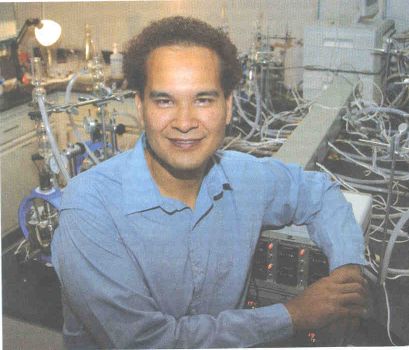
| Research |  |
References |  |
Group Members |  |
Techniques |  |
Facilities |  |
Typical Data |
UNLV Transmutation Research Program Strives to Improve Safety of Nuclear Waste
By Gian Galassi
For many people nuclear power still evokes catastrophic images of Hiroshima and Nagasaki, the accidents at Three Mile Island and Chernobyl, and, here in Nevada, the possibility of becoming a dumping ground for the rest of the country’s nuclear waste.But UNLV scientists and students are currently developing technologies that could improve nuclear energy’s tainted reputation – research that could lead to real solutions for the nuclear industry’s most contentious problems.
Established in 2001 with a $3 million grant from the U.S. Department of Energy, UNLV’s Transmutation Research Program (TRP) is a multi-disciplinary effort to address the ecological and economical management of the country’s used nuclear fuel. Spanning six departments in three colleges and involving more than 30 faculty members and 37 graduate students, the TRP is one of the most ambitious research efforts in the university’s history.
The program, administrated by the Harry Reid Center of Environmental Studies (HRC), is a component of the Advanced Fuel Cycle Initiative, a national program born out of the Los Alamos National Laboratory in New Mexico. The TRP currently supports 16 separate graduate research projects, called tasks, which examine the technological requirements of a process called nuclear transmutation.
Simply defined, nuclear transmutation converts volatile, radioactive isotopes into more stable isotopes by changing their nuclear structure. This is done through neutron-induced fission or neutron-capture processes conducted in nuclear reactors or particle accelerators. The result of both fission and neutron-capture in problematic isotopes is the same: the transformation of the most dangerous materials in used nuclear fuel into safer, more table, low-level waste. Through transmutation, the life span of the most problematic materials in the nuclear waste could be reduced by as much as 95 percent – from roughly 10,000 years to fewer than 500 – thereby eliminating many long-term environmental and safety concerns.
“Transmutation has the potentials for completely doing away with the need for a deep geological repository like Yucca Mountain,” said Anthony Hechanova, a nuclear engineer and director of the TRP. “It just depends how far you want to go with the process. There are some concepts that look at having all waste streams classified as low-level, which would allow for their disposal at any of the many low-level waste sites around the country.”

Anthony Hechanova, director of the Transmutation Research Program, hopes that UNLV researchers and students will develop ways to transform the most dangerous materials in used muclear fuel into safer, more stable waste that can be easily stored or recycled.
Students and faculty from the mechanical engineering, computer and electrical engineering, physics, health physics, chemistry and geoscience departments are conducting the research.
Just two months after the program received its initial grant in 2001, students produced computer models of accelerator components that Los Alamos scientists were able to use on advanced nuclear systems.
Hechanova said that even he was surprised with the rapid process of the program and the quick results of the research. “There has been such an interest in the project from faculty and students that, in a very short period of time, we accomplished more than I think any of us could have imagined,” he said. “The work that we’ve been able to do has helped make UNLV the nation’s top school in transmutation research.”
Although the elimination and reduction of harmful byproducts of nuclear energy is a considerable accomplishment, it is by no means the only benefit of transmutation. Researchers are also investigating benefits than could lead to dramatic breakthroughs in homeland security, environmental protection, energy production and nuclear medicine and therapy.
But the most practical outcome of the transmutation process may also be the most controversial. Most of the energy released during the transmutation of waste process – equivalent to 10 billion barrels of oil – can be harnessed to generate large amounts of electricity. What’s more, the electricity produced could not only be sold to offset the cost of transmutation, but would also provide a relatively benign energy source.
“We simply cannot sustain ourselves on fossil fuels for much longer,” said Hechanova. “Transmutation is one of the best possible solutions to this problem because it shows how we can maximize nuclear energy by getting the most out of the material we already have. And it won’t contribute whatsoever to the global warming problem because it doesn’t produce any of the greenhouse gases.”
Even with the technological and political challenges ahead, he is confident about the program’s future. Plans are already under way to expand campus facilities. They include construction of a thermal hydraulics lab, in which phenomena, such as the corrosion and strength of materials used during transmutation, will be examined.
Four new research tasks will be added, as will new faculty members in the areas of nuclear physics, molten metal coolant technology, and reactor physics. Hechanova also hopes to build complementary academic programs in radiochemistry, material science and engineering, and nuclear engineering.
“At the rate we’re going, UNLV will soon be among the most respected nuclear research institutions in the country,” said Hechanova. “Our students are playing a critical role in putting the U.S. back at the forefront of nuclear science and technology. Their future in this field is as bright as they want it to be.”
This article originally appeared in the December 2003 issue of “Inside UNLV.”